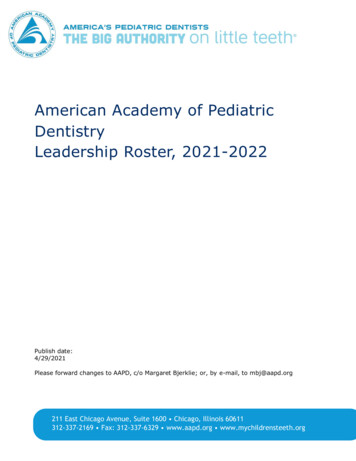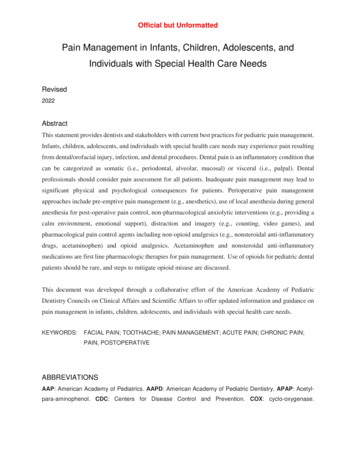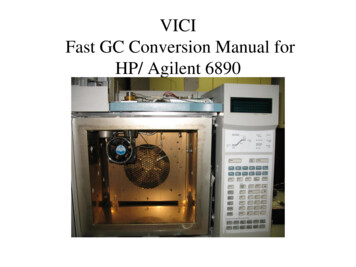
Transcription
FAST FACTSAMERICAN ACADEMY OF PEDIATRIC DENTISTRY 2014Twelve Great Story Ideas1. Dental Care for the BabyONE dental visit when there’s ONE tooth can equal ZERO cavities.2. Cosmetic and Restorative DentistryNew treatments to enhance or restore a child’s smile.Half of American children get cavities – Learn best treatment choices for children.3. Behavior GuidanceParents should exercise important rights as partners in dental decisions.4. Diet and Dental HealthIt’s not what children eat, but how often, and candy can be OK if children are conscientious.5. FluorideFluoride not only helps prevent tooth decay, it cures beginning cavities.6. How to Select a DentistHow pediatric dentists are different from general dentists.7. Dental Care for the PreschoolerTips for parents on a great dental visit.8. Dental Care for School-Age Children & SealantsA count down to dental health: Five steps to a cavity-free child.Sealants: The invisible protector and the best-kept secret in the dental office.9. Dental Care for the TeenagerWhy teens may get their first cavity at the same time they get a driver’s license.10. Children at RiskTwenty-five percent of our nation’s children have 80 percent of the cavities.11. Dental Care for Special-Needs Children & AdultsEvery person can enjoy a healthy smile and benefit from preventive dentistry.12. Sports Safety & Dental EmergencyHow to keep children off the “injured list.”What to do when a child has had a tooth knocked out.The American Academy of Pediatric Dentistry (AAPD), founded in 1947, is an organization of more than 8,000dedicated professionals with special training in children’s oral health. Pediatric dentists and their staff work in apediatric environment because they enjoy working with children. Pediatric dentists are advocates for children.The Academy emphasizes a three-part approach to caring for children:1. Prevention & Treatment: treating infants, children and adolescents in the dental office2. Education: teaching children, parents and dental professionals about how to provide the best possible care3. Research: working to develop improved methods of preventing oral problemsPediatric dentistry is one of nine dental specialties recognized by the American Dental Association. Pediatricdentists are the pediatricians of dentistry. They provide both primary and specialized oral health care for infantsand children through adolescence, including those with special health care needs. Their professional educationincludes two to three years of specialized study after completing dental school.2013 FAST FACTS
DENTAL CARE FOR YOUR BABYSTORY IDEAS When does one plus one equal zero? ONE baby tooth ONE pediatric dental visit ZERO cavities. First dental visits are mostly educational. The AAPD recommends that every child visit the dentist by thechild's first birthday. The American Dental Association and the American Academy of Pediatricsrecommend a child visit the dentist by age one as well. This “well baby check” for the teeth can establisha dental home and helps ensure that parents learn the tools they'll need to help their children remaincavity-free. A 2006 scientific paper in Pediatric Dentistry revealed that children who waited past their first birthdayand did not see a dentist until age two or three "were more likely to have subsequent preventive,restorative and emergency visits." Pacifier or thumb? Cloth or disposable? Breast milk or formula? Debates rage around new parents, just ata time when they’re too tired to tie their own shoes. The AAPD solves the first of these parent dilemmaswith a vote for pacifiers over thumbs to comfort fretful babies. Babies can “catch” cavities from their caregivers. In 71 percent of the cases, the mother is the source.Research indicates that the cavity-causing bacteria known as Streptococcus mutans can be transmittedfrom mothers to infants even before teeth erupt. The better the mother’s oral health, the less the chancethe baby will have problems.GREAT QUOTES“A child should be seen by a pediatric dentist, no matter how young that child is, if the parent thinks there could be a dental problem. No childis too young for good dental health.”--Dr. Ross Wezmar, Pediatric Dentist, Scranton, Pa.“Pacifiers have a few rules of thumb, pun intended. The three things to consider are frequency (How often do they suck?); duration (How longdo they suck?); and intensity (Can you hear it across the room?).”--Dr. Arthur J. Nowak, Pediatric Dentist, Iowa City, IowaPARENT TIPS: HEALTHY TEETH FOR BABIES Before the teeth erupt, clean the baby’s mouth and gums with a soft cloth or infant toothbrush at bath time.This helps ready the baby for the teeth cleaning to come. When the teeth erupt, clean the child’s teeth at least twice a day with a toothbrush designed for smallchildren. Take the baby to see a pediatric dentist by the baby’s first birthday. The earlier the visit, the better. It isimportant to establish a dental home to ensure that the child’s oral health care is delivered in acomprehensive, ongoing, accessible, coordinated and family-centered way by the dentist. If the baby is placed to sleep with a bottle, use nothing but water. When a child is given a bottle containingsugary liquids such as milk, formula or fruit juice, the teeth are under attack by bacterial acid for extendedperiods. This can cause cavities in babies called “early childhood caries,” formerly known as baby bottle toothdecay. Breast-feeding has been shown to be beneficial for a baby’s health and development. However, if the childprefers to be breast-fed often or for long periods once a tooth appears and other foods/beverages have beenintroduced into her diet, she is at risk for severe tooth decay. Clean the baby's mouth with a wet washclothafter breast-feeding, and encourage a bottle with plain water during the nighttime. Never dip a pacifier in anything sweet; it can lead to serious tooth decay. Wean the infant from the bottle by one year of age.2013 FAST FACTS
FLUORIDE FOR BABIES Even though the baby teeth have not erupted, infants still need fluoride to help developing teeth grow strong.A pediatric dentist will determine the child’s fluoride needs during the initial consultation. Children older than six months may need a fluoride supplement if their drinking water does not contain theideal amount of fluoride. Fluoride has been shown to reduce tooth decay by as much as 50 to 70 percent.1 A pediatric dentist will help determine whether the child needs a fluoride supplement and, if so, will prescribethe proper amount based upon the child’s age, fluoride levels in her primary source of drinking water, andother dietary sources of fluoride. Fluoride is conveniently available in fluoride drops or in combination withprescription vitamins.PACIFIER OR THUMB? Babies suck even when they are not hungry (a natural reflex called non-nutritive sucking) for pleasure, comfortand security. In fact, some babies begin to suck on their fingers or thumbs even before they are born. In the pacifier-versus-thumb debate, the AAPD votes for pacifiers over thumbs to comfort new babies. Apacifier habit is easier to break at an earlier age. The earlier a sucking habit is stopped, the less chance the habitwill lead to orthodontic problems. Sucking on a thumb, finger, or pacifier is normal for infants and young children; most children stop on theirown. If a child does not stop by herself, the habit should be discouraged after age three. Thumb, finger and pacifier sucking all can affect the teeth essentially the same way. If a child repeatedly suckson a finger, pacifier or other object over long periods of time, the upper front teeth may tip outward or notcome in properly. Other changes in tooth position and jaw alignment also may occur. Some oral changes caused by sucking habits continue even after the habit stops. Prolonged sucking can createcrooked teeth or bite problems. Early dental visits provide parents with information to help their children stopsucking habits before they affect the developing permanent dentition. A pediatric dentist can encourage the child to stop a sucking habit and discuss what happens to the teeth andmouth if the child does not stop. This advice, coupled with support from parents, helps many children quit. Ifthis approach does not work, a pediatric dentist may recommend behavior modification techniques or anappliance that serves as a reminder for children who want to stop their habits.PARENT TIPS FOR SAFE PACIFIERS Never dip the pacifier into honey or anything sweet before giving it to a baby. Never attach a pacifier to the child’s crib or body with a string, ribbon or cord. A pacifier’s shield should be wider than the child’s mouth. Discontinue use if the child can fit the entirepacifier in his mouth. Inspect pacifiers frequently for signs of wear or deterioration; discard if the bulb has become sticky, swollen,or cracked. Never leave an infant unattended with a pacifier in her mouth, or let her sleep with a pacifier. Never substitute a bottle nipple for a pacifier.2013 FAST FACTS
PARENT CHECKLISTTHE FIRST DENTAL VISITScheduling your child’s appointmentDetermining the success of the dental visit. Schedule the first dental visit and establish adental home by child’s first birthday. The pediatric dental practice did not keep uswaiting. (If there was a wait, I was satisfiedwith the staff’s explanation in regards to thedelay.) Choose a pediatric dental practice. Appreciatetheir special training. Select an appointment time when the child isusually alert, not tired. Provide a complete medical and dental historyabout the child. Consider visiting the office or its website beforeyour child’s appointment to become familiarwith the practice and to learn what to expecton the first visit. The pediatric dentist gently but thoroughlyexamined the child’s mouth. He observed oraland facial development and looked for signsof potential problems. The pediatric dentist informed the parentand/or caregiver about the child’s toothdevelopment, the causes and prevention oforal diseases and appropriate diet and homedental care. The pediatric dentist and members of the dentalteam answered questions on a variety oftopics, such as diet, teething, thumb sucking,pacifiers and fluoride. The dentist and support staff did everythingpossible to help the child feel comfortableduring the visit.VISUAL POSSIBILITIESFollow a child through a dental visit. See how the child and parent react to “child-friendly” treatmentand explanations.FOR MORE INFORMATIONErika HoeftPublic Relations Senior ManagerAmerican Academy of Pediatric Dentistry211 East Chicago Avenue, Suite 1700Chicago, Illinois 60611-2663Phone: 312-337-2169Fax: 312-337-6329www.aapd.org2013 FAST FACTS
COSMETIC & RESTORATIVE DENTISTRY FOR CHILDREN AND TEENSSTORY IDEASChildren smile when they are proud of their teeth. At school and at play, a healthy smile helps them feel moreconfident. A pediatric dentist can tell parents about new treatments to enhance or restore a child’s smile.Michael fell and knocked a tooth out during a field hockey match with his friends. Julie wants a brighter smile whenshe goes onstage to accept her arts scholarship. They should talk with a pediatric dentist. New dental treatments cancreate beautiful smiles and the treatment does not have to break a parent’s bank account.WHITENING TOOTHPASTES: DO THEY REALLY WORK?Some teens stand in the drugstore and wonder if toothpastes with “whitening power” really work. Whiteningtoothpastes contain chemicals or polishing agents that can remove stains from the teeth. (That said, all toothpastes havemild abrasives that help remove surface stains.) If the teeth are darker than they used to be because of surface stains,whitening toothpastes can brighten a teen’s smile. On the other hand, if the teeth are darker because of deeper stains,perhaps from an injury or certain medications, whitening toothpastes will not give the teen effective results. Unlikebleaching, these toothpastes do not change the color of the teeth to a whiter, brighter shade. If a teen is interesting inchoosing this route, he must be sure to choose a brand that contains fluoride. Teens are still very susceptible to toothdecay.BLEACHING: GREAT CHOICES TO BRIGHTEN YOUR SMILEBleaching will brighten the color of teeth that are discolored, stained, or have been darkened as a result of injury. Itchanges the color of the child or teen’s teeth without removing any tooth structure. One treatment choice is in-officebleaching. A concentrated bleaching agent is applied to his teeth and then activated with heat or light. The visits takeabout an hour, and usually one to four visits are needed. The pediatric dentist can lighten as few or as many teeth asneeded.One method is a bleaching kit that the child or teen can receive from the pediatric dentist and use at home. In thefirst visit, the pediatric dentist takes a model of the child’s teeth. In the second visit, the child picks up the custom-madebleaching tray and the bleaching gel. He wears the tray, filled with the bleaching gel, usually at night for several nights.This approach is best for older children and teens whose front permanent teeth are fully erupted.Whichever approach you choose, bleaching is fairly comfortable, and the side effects are few. Some patients findtheir teeth are more sensitive to hot and cold foods, but the sensitivity disappears after a few days. A toothpaste forsensitive teeth may help.MICROABRASION: GOOD FIRST CHOICE FOR TOOTH STAINS OR SPOTSMicroabrasion is an excellent option for children or teens who want to change the color of certain areas or spots onthe teeth, rather than lighten the color of the whole tooth. The pediatric dentist removes microscopic bits of discoloredtooth enamel with an abrasive and a mild acid. Treatment usually can be completed in one visit. Microabrasion is aconservative treatment, removing little tooth structure.Will microabrasion remove a spot or stain completely? It is difficult to predict. Success depends upon a number offactors, especially the type and extent of discoloration. Surprisingly, brown or dark stains are removed more readilythan white ones. Microabrasion works better on surface discoloration than it does on deeper stains caused by injury orcertain medications.BONDING AND VENEERS: RESTORE THE LOOK OF CHIPPED, BROKEN ANDPITTED TEETHThese treatments can restore the original shape of a chipped, broken or pitted tooth. They can brighten frontteeth that are stained or discolored. The treatments involve bonding tooth-colored plastic or cementing tooth-coloredveneers to the teeth. They require little loss of tooth structure, and they restore the natural appearance of teethand encourage a confident smile.Bonding materials, often called composite resins, are tooth-colored plastics. During the treatment called bonding, thebonding material is applied to the tooth, formed into the proper shape, and hardened with a light or chemical process.2013 FAST FACTS
The treatment typically takes one or two visits.Veneers are thin shells of tooth-colored plastic or porcelain. They are custom-made, usually by a dental laboratory,and then bonded onto the teeth using a tooth-colored cement. The treatment takes multiple visits.Bonding and veneer treatments may greatly improve the look of a smile and can last for several years. However,there are some limitations. Although bonding and veneers are conservative, they may require some loss of toothenamel. Also, bonded teeth and veneers are simply not as strong as the original tooth structure. Nail biting, hard foodsand sports accidents can damage them. They must be maintained with good oral hygiene and regular dental visits.PORCELAIN CROWNS: STRONGEST TREATMENT FOR RESTORING YOUR SMILEPorcelain crowns can give beautiful cosmetic and restorative results for discolored, chipped or broken teeth.However, parents must consider two realities: First, crowns are more costly than other treatments; and second, a crownrequires the removal of a significant amount of tooth structure. On the other hand, crowns are stronger than the othercosmetic choices and can last for many years with good dental health habits. Porcelain crowns are reserved forpermanent teeth that are fully erupted with the gum tissue at its adult position.Crowns typically are made of metal covered with tooth-colored porcelain or a plastic resin. The tooth is prepared byshaping it and removing a part of the outside tooth structure. (The tooth must be made smaller in size so the crown canfit over it.) The crown is custom-made, usually by a dental laboratory, to precisely fit the prepared tooth. The crownfits over the tooth and is cemented into place.ORTHODONTIC TREATMENT: ADVANTAGES GO FAR BEYOND COSMETICSA pediatric dentist can identify crowded or crooked teeth and actively intervene to guide the teeth as they come inthe mouth. Not only will this improve the look of the child’s smile, but early orthodontic treatment may prevent moreextensive treatment later.The advantages of orthodontic care far surpass appearance. Braces and other orthodontic appliances can straightencrooked teeth, guide teeth into proper position as they come in, correct bite problems, and even prevent the need fortooth extractions. Straight teeth not only look better, but are easier to keep clean and therefore less susceptible to toothdecay and gum disease.Unlike the other treatment choices that start and finish in a shorter period of time, orthodontic treatment takes placeover the years as the child’s mouth grows and changes. A commitment to regular dental visits and good home care is amust. Orthodontic treatment is a significant financial investment as well. However, since it offers important healthbenefits, it may be covered at least in part by dental insurance.2013 FAST FACTS
COSMETIC CHOICES FOR CHILDREN AND TEENSTREATMENTGOALSWhitening toothpastesBrighten teethPROS AND CONSRemove surface stains but does not lighten the color of the teethOver-the-counterLighten teethwhitening kits(strips, gels in preformed trays)Patient convenience, low cost; limited control (not for singletooth) and efficiency, tissue irritation from poorly-fitting trayCustom-made bleachingtraysLighten teethGreater efficiency than over-the-counter kits, intimate fit;requires multiple applicationsIn-office bleachingWhitens discolored teethLightens and brightens the color of a tooth or teeth, verycomfortable, professional control with protection of thegums during treatment; relativelymore costly than at-home methods.MicroabrasionBrighten discolored areason individual teethImproves spots and stains on teeth, very comfortable;less predictable resultsBonding and veneersRestore discolored teethGreatly improves the look of the teeth, last for several years,Restore a tooth that iscomfortablechipped or brokenMask developmental defectssuch as pitted or small teethPorcelain crownsRestore discolored teethGreatly improves the look of the teeth, very durable, treatmentRestore a tooth that ismore extensivechipped or brokenRestore a tooth withextensive decay.Mask developmental defects suchas pitted or small teethOrthodontic treatmentCorrect crooked orcrowded teethBenefits go far beyond cosmetics to correct bite problems andprevent future dental problems, most extensive investmentof time and finances.VISUAL POSSIBILITIES Before-and-after photos of microabrasion and bleaching techniques Before-and-after photos of bonding and veneers for discolored and chipped teeth Photos of a porcelain crown, before and after placement2013 FAST FACTS
RESTORATIVE DENTISTRY“Look Ma, no cavities” is what every parent wants to hear at the end of a dental appointment, and preventive dentistry iskeeping more children free of decay than ever before. But when a child faces a dental problem, treatment is the right andresponsibility of a parent. You have the right to be fully informed about the treatment choices for your child’s condition.You have the responsibility to work with the pediatric dentist to make the best treatment decision for your child. Half of allAmerican children under the age of 12 have never had a cavity. That means half of them do. If the child has tooth decay,new treatments are available that are far more attractive and comfortable than in the past. A parent can be a wise consumerif you know your options and discuss them with your pediatric dentist.TOOTH DECAY: TREATMENT OPTIONS To treat a cavity, the first step is to remove the decayed part of the tooth. Pediatric dentistry now offers threechoices for decay removal: the traditional dental “drill”, microabrasion and laser treatment. The dental “drill”, called a handpiece, remains the technique of choice for removing tooth decay. High-speedhandpieces make treatment quicker and more comfortable than in the past, although children still may feelvibrations during the process. In microabrasion, which is different than cosmetic forms of microabrasion, a high-pressure instrument cutsaway decay by blowing a stream of tiny particles at the tooth. Microabrasion is comfortable for children andfree of the vibrations of the drill, although it cannot be used for all types of cavities. A dental laser light can cut through the decayed part of the tooth to remove it. It is usually comfortable andis free of the vibrations felt with the drill. Laser treatment may take longer than the other two approaches and cannot be used on teeth that alreadyhave fillings. Because this approach is relatively newer than more traditional approaches, many pediatricdentists are taking a “wait and see” attitude on the practicality and effectiveness of lasers.Once the decay is removed, the next step is filling the hole where the decay was. Talk to a pediatric dentist about whichof the many choices of filling materials is best for the child.WHY FILL BABY TEETH WHEN THEY FALL OUT ANYWAY?While it is true that baby teeth do eventually come out, it is also true that they are important to a child in the meantime.Primary or baby teeth hold space for the permanent teeth to grow in. If one is lost, the others can shift into the emptyspace and prevent the permanent tooth from erupting. This often means a crooked smile in a child’s future. In addition, adecayed tooth can become abscessed and cause discomfort for a child. “Tooth decay causes significant pain, loss ofschool days and may lead to infections and even death.” 2 Left untreated, dental caries can result in a broad range offunctional impairments that have far-reaching implications for growth, development, school performance, and peerrelationships.PREVENTIVE RESINS: EXCELLENT CHOICE FOR CAVITIES CAUGHT EARLYIf a child has a tiny cavity on the chewing surface of a baby tooth or permanent tooth, then she may be a good candidatefor preventive resin treatment. After the decay is removed, the tooth is filled with a tooth-colored plastic and then coatedwith a sealant. The filling is virtually invisible, and the tooth is free of decay and protected by the sealant.2013 FAST FACTS
TOOTH-COLORED FILLINGS: VIRTUALLY INVISIBLE TREATMENT FOR SMALLERCAVITIESTooth-colored fillings are made from durable plastics called composite resins. Similar in color and texture to naturalteeth, the fillings are less noticeable and more attractive than other types of fillings. Your child can smile, talk and eatwith confidence. Certain tooth-colored filling materials (such as glass ionomers) even release fluoride, resulting in atooth that is more resistant to decay. In addition, tooth-colored fillings are compatible with dental sealants. A tooth canbe filled and sealed at the same time to provide extra decay protection.Resin fillings are not for every cavity. They work best in small areas of decay in low-stress areas. A pediatric dentistmay not recommend a tooth-colored filling for a large cavity in a back tooth. Resin fillings may cost more than amalgam(silver) fillings because they take longer to place. Plastic fillings are not as durable as metal fillings.AMALGAM FILLINGS: A STRONG, PRACTICAL CHOICE FOR CHILDRENAmalgams, the silver-colored fillings you probablygot as a child, are still serving children well today.Amalgam fillings are made of a mixture of metalsincluding silver, copper, tin, and mercury. Theirrelative low cost, ease of placement, and durabilitycontribute to their continued use. However, amalgamfillings require removal of healthy tooth structure inorder to achieve adequate retention. Because they lackthe aesthetic appeal of composite resins, their use islimited to back teeth with small to moderate sizedcavities.Used for over 100 years, amalgam fillings have beenproven safe with patients all over the world. In a fewrare cases, some patients are allergic to the metalsused in amalgam fillings. If a child has an allergy tometals, a filling material other than amalgam may bechosen. Amalgam fillings should not be used inprimary molars where decay is extensive or forpatients who are at high risk for decay and havemultiple and/or large cavitiesPREFORMED (STAINLESS STEEL) CROWNS: A COST-EFFECTIVE CHOICE FOR SEVEREDECAYWhy would a parent choose a crown for a child? Here are some possible reasons: If a cavity is not caught early, the decay can destroy so much of the tooth structure that there is not enoughleft to support a filling. A crown will save the tooth. If a child has a root canal, which will leave the tooth more susceptible to fracture, a crown is recommended. A crown can restore a tooth with a developmental defect or a tooth fractured in an accident. If a child is at high risk for cavities and compliance with daily oral hygiene is poor, a crown will restore thedecay while protecting the remaining surfaces of the tooth. If a child’s cooperation is affected by age, behavior or medical condition, a stainless steel crown is likely tolast longer and possibly decrease the frequency for sedation or general anesthesia with its increased costsand risks. Stainless steel crowns are more cost effective and are the treatment of choice for large areas of decay.Preformed (stainless steel) crowns have been used over 50 years to save teeth that otherwise would be lost or when othertreatments would fail. One of the strongest and most durable services in dentistry, they last longer than fillings and costless than other types of crowns. Their greatest disadvantage is that stainless steel crowns are not the color of teeth, butthe color of polished silver.The treatment process is the same for stainless steel crowns as for tooth colored crowns. First, the decay is removedfrom the tooth. Next, the tooth is made smaller so the crown can fit over it. The crown is cemented into place.2013 FAST FACTS
TOOTH-COLORED CROWNS: A STRONG TREATMENT WITH NATURAL LOOKTooth-colored crowns can be selected as treatment for the same reasons as stainless steel crowns. For example, theyare recommended for treating severe decay or restoring a tooth with a fracture or developmental defect. On the plusside, tooth-colored crowns are natural looking and can provide an excellent cosmetic result for your child. On theminus side, they are more expensive, may be less durable and may require longer treatment time for a child.There are 2 types of tooth-colored crowns: preformed and custom-fabricated. Preformed crowns are stainless steel crowns with tooth-colored veneers. They come in standard sizes, shapesand color, and are adapted to a prepared baby tooth. Preformed aesthetic crowns are subject to fracture or loss ofthe facing. Custom-fabricated crowns are made in a laboratory to match the size, shape and color of the patient’s naturalteeth. They typically are made of metal covered with porcelain. Custom-fabricated porcelain crowns are reservedfor permanent teeth that are fully erupted with the gum tissue at its adult position.RESTORATIVE CHOICES FOR YOUR CHILDTREATMENTPreventive resinsCONDITIONTiny cavitiesLook natural, great preventive measure, smaller investmentTooth-colored fillingsSmall cavities in back teeth,cavities in front teethLook natural, work best in low-stress areas, may cost morethan amalgam fillingsAmalgam fillingsSmall to moderate cavitiesVery durable, less natural-looking, for back teeth, may costless than tooth-colored fillingsPreformed (stainlesssteel) crownsSevere decay; tooth withfracture, developmentaldefect, root canal treatmentVery durable, less natural-looking, more affordable thantooth-colored crownsSevere decay; tooth withfracture, developmentaldefect, or root canal treatmentLook natural, performance may be less durable, morecostly than stainless steel crownsTooth-colored crownsPROS AND CONSVISUAL POSSIBILITIESPhotos of a tooth-colored fillingPhotos of an amalgam fillingPhotos of a crown, before, during and after placementFOR MORE INFORMATIONErika HoeftPublic Relations Senior ManagerAmerican Academy of Pediatric Dentistry211 East Chicago Avenue, Suite 1700Chicago, Illinois 60611-2663Phone: 312-337-2169Fax: 312-337-6329www.aapd.org2013 FAST FACTS
BEHAVIOR GUIDANCESTORY IDEAS Parents want the best for their children, whether their children are at school, camp or the dental office.Two important steps will help your child receive the best dental care. First, choose the right dentalprofessional for a particular child. Second, be an active partner in the child’s dental health decisions. Parents have two important rights in the dental treatment of their children. The first is a right toinformation. As a parent, you should know exactly what treatment your child will receive – and why.The second is a right of choice. Parents can support or deny any treatment approach suggested fortheir child. This is called informed consent. Each child responds in her own way to a dental visit. Pediatric dentists stand ready with a variety ofmethods to help an individual child feel comfortable with dental treatment. You can and should be apartner in selecting which technique will work best for your ch
First dental visits are mostly educational. The AAPD recommends that every child visit the dentist by the child's first birthday. The American Dental Association and the American Academy of Pediatrics recommend a child visit the dentist by age one as










